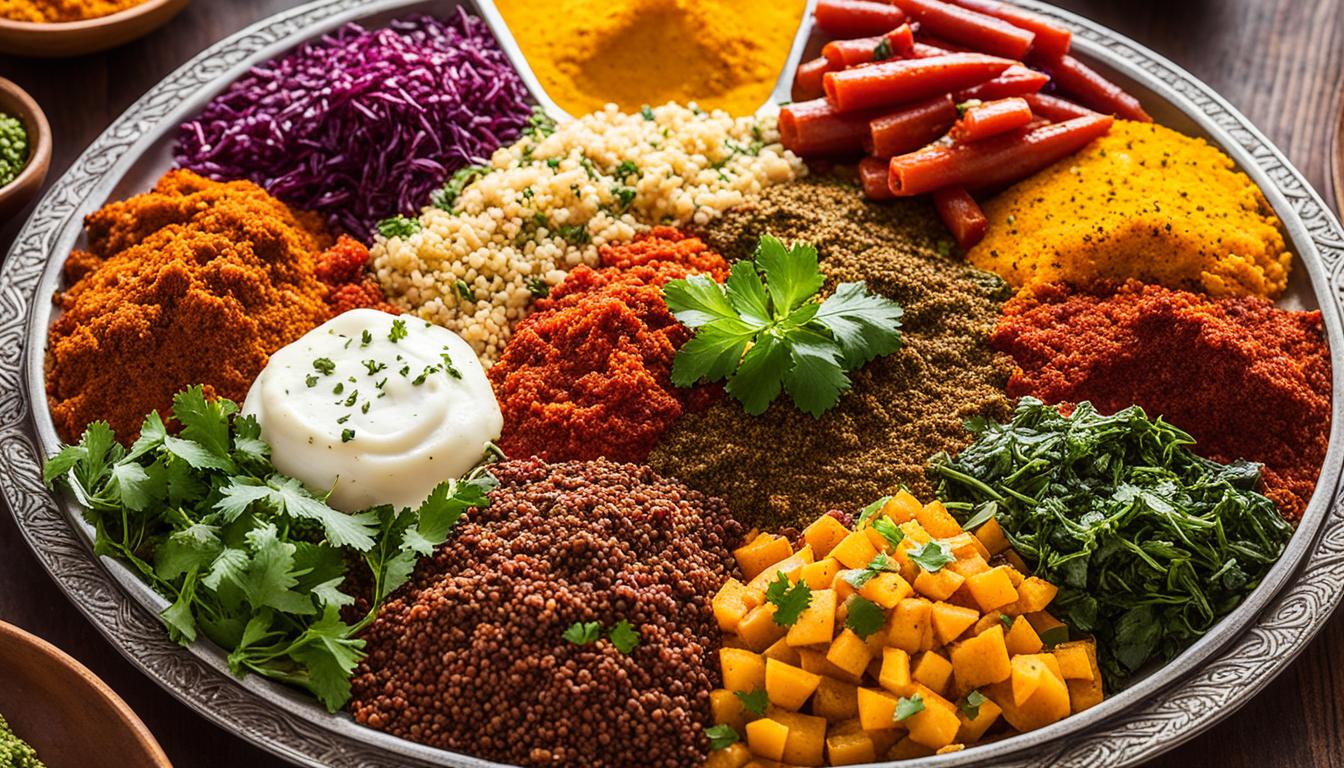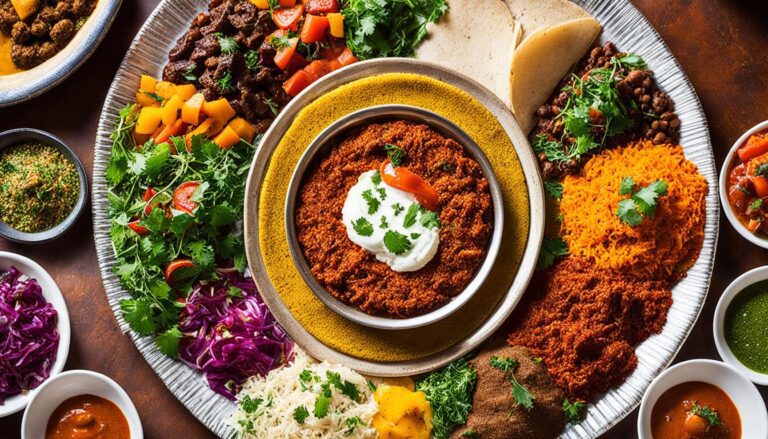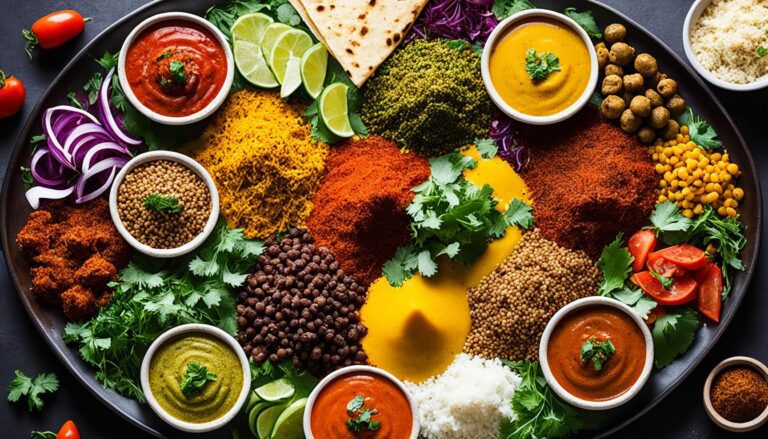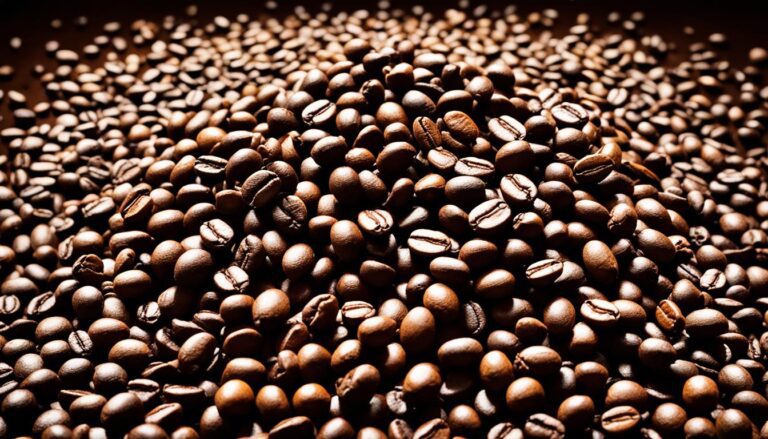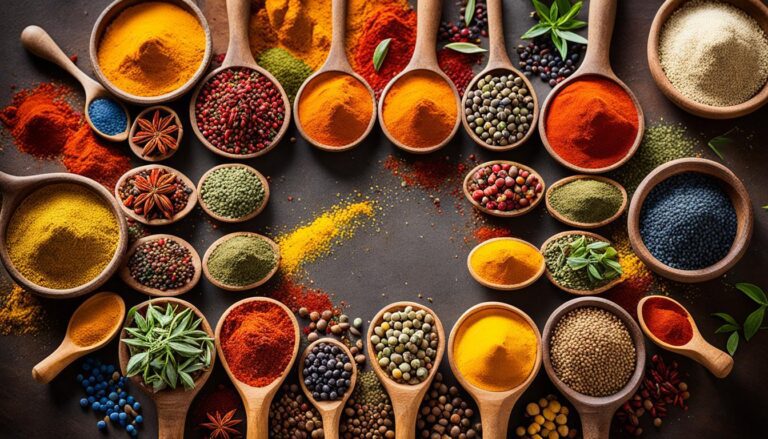Does Ethiopian Food Have Dairy?
In this article, we will explore the fascinating world of Ethiopian cuisine and answer a burning question: Does Ethiopian food include dairy products? Join us as we delve into the vibrant flavors, unique ingredients, and culinary traditions that make Ethiopian cuisine a culinary adventure like no other.
When you think of traditional Ethiopian dishes, what comes to mind? Rich stews, aromatic spices, and the iconic sourdough flatbread, injera, are just a few elements that make Ethiopian cuisine so special. But does this diverse and flavorful cuisine incorporate dairy products? Prepare to be surprised by what we uncover!
From the savory wats to the fiery berbere spice, Ethiopian food is known for its ability to tantalize taste buds. But does dairy play a role in creating these tantalizing flavors? Is Ethiopian cuisine entirely dairy-free, or are there hidden dairy ingredients waiting to be discovered? Join us on this journey as we debunk myths, challenge assumptions, and uncover the truth about Ethiopian food and dairy.
Key Takeaways:
- Ethiopian cuisine is renowned for its bold flavors and diverse culinary traditions.
- Traditional Ethiopian food predominantly avoids the use of dairy products.
- However, the absence of dairy opens up a world of delicious vegan and dairy-free options.
- Modern influences have introduced dairy-based dishes in some Ethiopian restaurants.
- We will guide you through the Ethiopian menu, highlighting dairy and dairy-free options.
Ethiopian Cuisine: A Culinary Adventure
Before delving into the presence of dairy in Ethiopian food, let’s take a moment to explore the diverse and vibrant culinary traditions of Ethiopia. Ethiopian cuisine is a melting pot of flavors and ingredients that will take your taste buds on an unforgettable journey.
At the heart of Ethiopian cuisine is the iconic injera, a sourdough flatbread that serves as both a versatile utensil and a staple food. It is made from fermented teff flour, a gluten-free grain that imparts a unique tangy flavor to the bread.
Accompanying the injera are a variety of wats, which are flavorful stews made with a base of onions, garlic, and Ethiopian spices. These wats can be made with different proteins, such as chicken, beef, lamb, or lentils, creating a symphony of flavors that cater to different dietary preferences.
A trip to an Ethiopian restaurant wouldn’t be complete without trying some of the famous delicacies like Doro Wat, a fiery stew made with chicken, and Kitfo, a spicy minced beef dish. These dishes showcase the bold and aromatic flavors that Ethiopian cuisine is known for.
One unique aspect of Ethiopian dining is the communal style of eating. It is customary to share a large platter of injera topped with various wats and side dishes, encouraging a sense of togetherness and camaraderie.
As you embark on this culinary adventure, get ready to discover the rich history and cultural significance of Ethiopian dishes. The blending of different spices, the use of traditional cooking techniques, and the pride in preserving ancient culinary traditions make Ethiopian cuisine a truly remarkable experience.
Key Ingredients in Ethiopian Food
To fully understand the composition of Ethiopian dishes, it is essential to explore the key ingredients used. Ethiopian cuisine is renowned for its rich and aromatic flavors, which are achieved through a careful selection of traditional ingredients.
One of the most notable aspects of Ethiopian cooking is the use of spices. Ethiopian spices play a crucial role in adding depth and complexity to the dishes. One of the most well-known spice blends is berbere, a fiery mixture of chili peppers, garlic, ginger, and various other spices. Berbere adds a bold and spicy kick to many Ethiopian dishes, infusing them with intense flavors and vibrant colors.
Another popular Ethiopian spice is mitmita. This blend typically contains a combination of ground chili peppers, cardamom, cloves, and other aromatic spices. Mitmita is commonly used to season meats and stews, lending a unique and captivating flavor profile to the dishes.
Traditional Ethiopian cuisine also incorporates a variety of lentils, vegetables, and grains. These ingredients form the foundation of many Ethiopian dishes, providing a nutritious and filling base. Lentils such as red lentils are commonly used in stews and soups, adding a rich and hearty texture. Vegetables like cabbage, carrots, and potatoes are often included in Ethiopian dishes, adding freshness and vibrant colors.
Whether it’s the aromatic spices like berbere and mitmita or the hearty lentils and vegetables, every ingredient in Ethiopian cuisine serves a purpose in creating a harmonious and flavorsome experience. These traditional Ethiopian ingredients come together to create a culinary journey that is both delicious and culturally significant.
Dairy-Free Delights: Vegan Options in Ethiopian Cuisine
While exploring the rich and diverse flavors of Ethiopian cuisine, we can’t ignore the abundance of vegan and dairy-free options that this culinary tradition offers. Ethiopian food is known for its vibrant spices, aromatic stews, and unique cooking techniques. And the best part? Many of these delicious dishes are already vegan or can easily be adapted to accommodate a dairy-free lifestyle.
Unlike some other cuisines, dairy is not a prominent ingredient in traditional Ethiopian dishes. Instead, Ethiopian cooking relies on a variety of plant-based ingredients to create bold flavors and satisfying meals. This makes Ethiopian cuisine a fantastic choice for vegans, lactose-intolerant individuals, or anyone looking to explore the world of dairy-free cooking.
One of the star ingredients in Ethiopian cuisine is injera, a sourdough flatbread made from teff flour. Injera serves as a versatile base for many Ethiopian dishes and is naturally gluten-free. It’s often served with a variety of vegan stews, known as wats, which feature a combination of vegetables, lentils, and aromatic spices.
Another popular vegan option in Ethiopian cuisine is Shiro, a flavorful stew made from ground lentils or chickpeas. This hearty dish is seasoned with spices like berbere and served alongside injera or rice. The absence of dairy allows the flavors of the spices and legumes to shine through, creating a truly satisfying culinary experience.
If you’re a fan of Ethiopian salads, you’re in luck! Many Ethiopian salads are traditionally dairy-free and bursting with fresh flavors. One example is the refreshing Timatim Salad, made with diced tomatoes, onions, and a zesty dressing of lime juice and spices. It’s a perfect accompaniment to any Ethiopian meal.
When it comes to beverages, Ethiopian culture has a lot to offer as well. Try a traditional Ethiopian coffee ceremony, where coffee is brewed slowly and served with local spices like cardamom and cloves. Or indulge in a glass of tej, a honey wine that is naturally dairy-free.
Embracing vegan Ethiopian food not only opens up a world of delicious flavors but also aligns with ethical and sustainable food choices. So why not embark on a culinary adventure and explore the dairy-free delights of Ethiopian cuisine?
Non-Dairy Ethiopian Beverages
As we explore the realm of Ethiopian food, it’s important to not only focus on solid dishes but also traditional beverages. In Ethiopian cuisine, you’ll find a delightful array of non-dairy drinks that complement the flavors of the cuisine. One such beverage is tej, a honey wine that has been enjoyed for centuries. Made from fermented honey and flavored with various herbs and spices, tej is a sweet, aromatic beverage often served in traditional Ethiopian restaurants. With its rich history and unique taste, tej is a must-try for those looking to experience authentic Ethiopian drinks.
Another popular Ethiopian beverage is coffee. Ethiopia is widely regarded as the birthplace of coffee, and Ethiopians have a deep appreciation for this aromatic drink. The traditional Ethiopian coffee ceremony is a cultural experience like no other, where coffee beans are roasted, ground, and brewed in front of you. The coffee is served in small cups and enjoyed with friends and family. This brewing process produces a bold and distinct flavor that showcases the unique Ethiopian coffee beans.
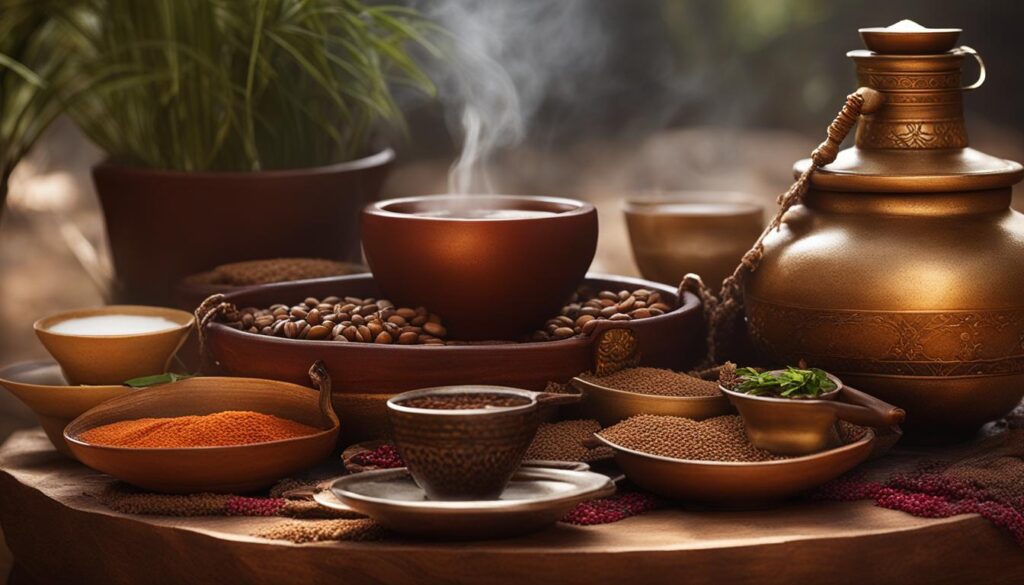
These non-dairy Ethiopian beverages provide a refreshing and flavorful alternative to dairy-based drinks. Whether you’re sipping on tej or immersing yourself in the traditional Ethiopian coffee ceremony, these beverages represent the rich cultural heritage and warm hospitality of Ethiopia. They perfectly complement the vibrant and diverse flavors found in Ethiopian cuisine. So, make sure to indulge in these traditional Ethiopian beverages during your culinary adventure!
Ethiopian Dairy: Modern Influences on Traditional Cuisine
While dairy is not traditionally a part of Ethiopian cuisine, modern influences and global fusion have introduced dairy-based dishes in some Ethiopian restaurants. This intriguing blend of Ethiopian flavors with dairy components creates exciting and unique options for those looking to experience a fusion of culinary traditions.
In these modern interpretations, dairy products are utilized to add richness and creaminess to traditional Ethiopian dishes. The addition of dairy creates a delightful contrast to the bold and aromatic flavors that are characteristic of Ethiopian cuisine.
One popular example is the incorporation of cheese, such as feta or cottage cheese, in certain Ethiopian dishes. This addition adds a tangy and savory element that complements the robust flavors of the spices and herbs used in Ethiopian cooking.
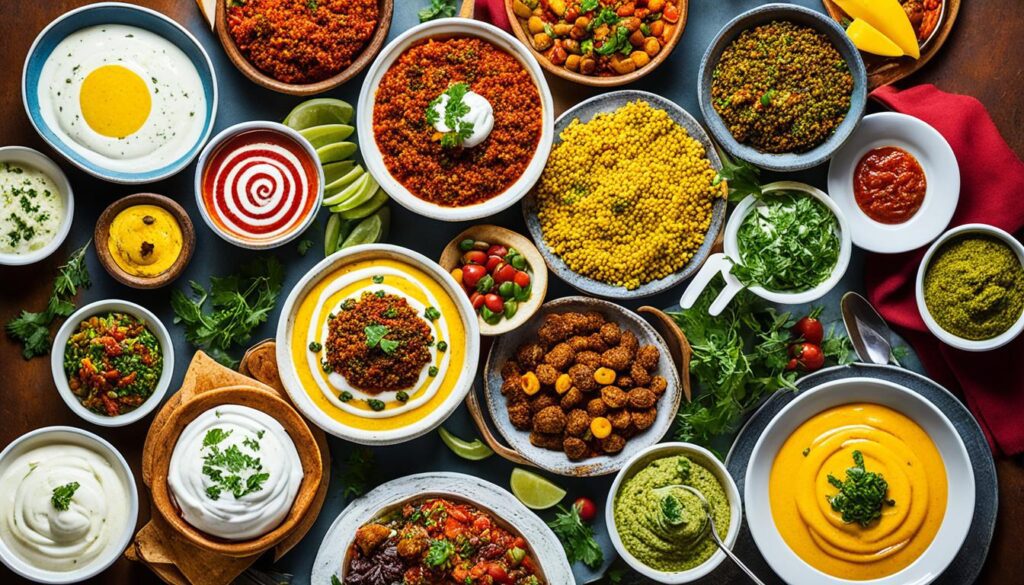
This image illustrates the harmonious marriage of dairy and Ethiopian flavors in a visually captivating way. As you can see, the fusion of traditional Ethiopian ingredients with dairy creates a visually appealing and enticing dish.
Other fusion dishes may combine Ethiopian spices and techniques with dairy-based sauces or creams, resulting in a unique culinary experience that celebrates both tradition and innovation. These dishes seamlessly blend the authenticity of Ethiopian flavors with the indulgence of dairy, offering a delightful twist to traditional Ethiopian cuisine.
So, if you’re an adventurous food lover who enjoys exploring culinary fusion, don’t miss the opportunity to try these modern Ethiopian dishes that incorporate dairy. They provide a creative and delicious take on traditional Ethiopian cuisine, showcasing the versatility and adaptability of Ethiopian cooking.
Exploring Ethiopian Menu: Dairy or Dairy-Free?
When dining at Ethiopian restaurants, it’s useful to know what to expect in terms of dairy options. Ethiopian cuisine is known for its rich flavors and diverse range of ingredients, but does it include dairy? Let’s explore the Ethiopian menu and discover whether lactose intolerance will be a concern for those seeking dairy-free options.
Traditional Ethiopian cuisine predominantly avoids the use of dairy products, making it a favorable choice for individuals with lactose intolerance or those following a dairy-free diet. However, it’s essential to note that some Ethiopian dishes may still contain dairy or dairy-derived ingredients.
One popular Ethiopian dish that may incorporate dairy is kitfo. Kitfo is a minced raw or lightly cooked beef dish that is traditionally served with cottage cheese or yogurt. If you have lactose intolerance or prefer to avoid dairy, you can request the dish without these accompaniments.
Another dish to consider is tibs, a flavorful Ethiopian stir-fry. While tibs typically do not contain dairy, it’s always a good idea to check with the restaurant about the ingredients used to ensure they align with your dietary preferences.
For those seeking fully dairy-free options, don’t worry! Ethiopian cuisine offers a wide variety of plant-based dishes that do not include dairy. From lentil stews like misir wat to vegetable dishes like tikil gomen, you can still enjoy a delicious and authentic Ethiopian meal without compromising your dietary restrictions.
When dining at an Ethiopian restaurant, it’s always helpful to inform the waitstaff about any dietary restrictions you may have, including lactose intolerance. They will be happy to guide you through the menu and suggest appropriate dairy-free options.
So, whether you’re lactose intolerant or simply prefer to avoid dairy, Ethiopian cuisine offers plenty of choices to satisfy your cravings. Embrace the unique flavors, vibrant spices, and diverse range of dairy-free dishes that make Ethiopian cuisine a culinary adventure for everyone.
Conclusion
In conclusion, traditional Ethiopian cuisine predominantly avoids the use of dairy products. This aspect of Ethiopian food makes it an excellent choice for those who follow a vegan or dairy-free diet. However, the absence of dairy does not compromise the rich and diverse flavors that Ethiopian cuisine is known for.
Whether you’re looking to experience the authentic taste of Ethiopia or explore the world of vegan Ethiopian dishes, there is a wide range of options available. From flavorful lentil stews to tangy injera, the vibrant assortment of plant-based ingredients will tantalize your taste buds and leave you craving for more.
Embracing traditional cooking techniques and utilizing a plethora of spices, Ethiopian cuisine showcases the culinary expertise of this East African nation. By utilizing grains, lentils, and vegetables, Ethiopian food offers a healthy and satisfying dining experience.
So, whether you’re seeking dairy alternatives or simply eager to indulge in unique flavors, Ethiopian cuisine is a true culinary adventure that should not be missed. Experience the magic of this vibrant and diverse cuisine and savor the unforgettable taste of Ethiopia.

